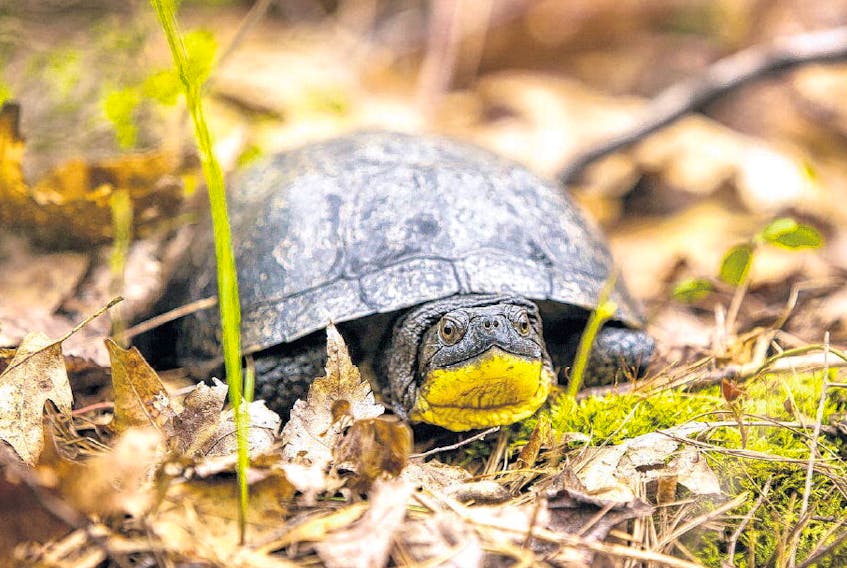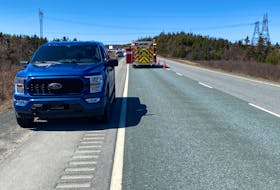Dillon-Lorrain emerged from a protected nest about 20 years ago and nested 16 eggs herself last spring on a beach in Kejimkujik National Park.
“It’s pretty groundbreaking,” said Carter Feltham, a 22-year-old Blanding’s turtle researcher withMersey Tobeatic Research Institute in Queens County. “It’s solid proof that one of the Blanding’s turtles survived from a protected nest all the way up to adulthood to reproduce herself.”
The turtle nested again this spring, a big deal considering the Blanding’s turtle is on the endangered species list and the research institute estimates there are fewer than 500 adults in Nova Scotia. With the exception of only a few concentrations there are just four established Blanding’s turtle populations in the southwestern area of the province: Kejimkujik National Park, McGowan Lake, Pleasant River and the Lower Medway River.
The research institute still has a legion of 70-odd volunteers that remain committed to the survival of the Blanding’s turtle, by monitoring nesting areas and the turtles throughout the year. They’re involved in protecting nests with cages to prevent predation, fitting the turtles with radio tracking devices and trapping the turtles in their habitats to help monitor populations. Signs are set up in each of the four areas urging motorists to look for turtle crossings.
Feltham, a volunteer Blanding’s turtle conservationist since she was seven years old, is heading into a master of biology degree program at Acadia University this
year. She says the population isn’t close to thriving but she sees signs of hope. Take for example in Lower Medway where a new population of Blanding’s turtles was discovered three years ago.
“We’ve been monitoring new populations there this summer, setting traps in areas where we knew there were turtles and other areas where we weren’t sure and we found new ones.
“We hadn’t been finding young turtles; they were mostly all old turtles. This year we found a six-year-old and a 12-year-old.”
“They thrive in areas where there’s little disturbance and development.
“In Lower Medway we didn’t even know they existed there until three years ago. People also attract scavengers and raccoons that eat the eggs. The turtles like swamps and meadows, areas people don’t generally like.”
Biologist Duncan Smith was one of the peoplebehind the slow-down signs that were first erectedalong roads near Blanding’s turtle habitats 10 yearsago and every summer they go back up. At the timehe was employed with Kejimkujik National Park and convinced the Department of Transportation to support the project, a partnership that continues today.
He remains a volunteer with the research institute.
“Turtles tend to have areas where they spend the summer, areas where they like to nest, where they like to overwinter,” said Smith. “They move through the landscape a lot more than people realize. Roads do two thing, they create barriers where animals need to cross. For turtles, they create nice places. They can get a lot of sun and a lot of heat and have nice gravel roadsides, which can often be used for nesting and it’s perfect for egg incubation.
With that come road fatalities. Two females the group had been tracking were killed on roads in the last 10 years. Both were mature, egg-carrying females.
“As humans we’re pretty good at changing our landscapes and we can do it pretty quick. We can change things pretty drastically. For critters that are long lived (they can live up to 75 years) like turtles it takes them a long time to adapt. If we change the landscape it can be really detrimental to the species.
“So if we can protect turtles, then hopefully we can keep them around for generations to come so our kids’ kids’ can still enjoy them.”
Both Smith and Feltham say the Blanding’s are a one-of-a kind critter.
“For me they’re really special,” said Smith. “They just seem to have smile on their face on the rare occasion you see them. They’re beautiful and distinctive with their larger shells, high tops, their yellow flecks, their bright yellow and orange necks.”
For the past decade and a half he’s been committed to seeing them eventually thrive in Nova Scotia.
“People say why worry about one species. Well, if you lose one species from the ecosystem, one, it’s sad, but two, it means something has changes quite drastically. So by protecting the Blanding’s turtles we’re contributing to environmental conservation and helping the turtle and ourselves at the same time.”









